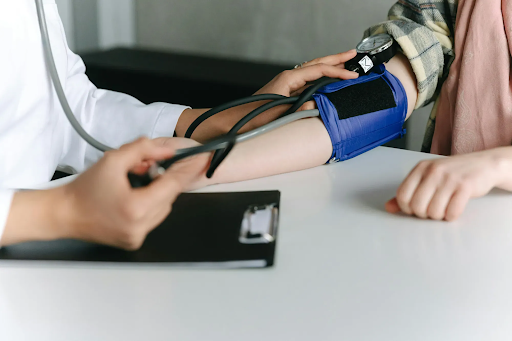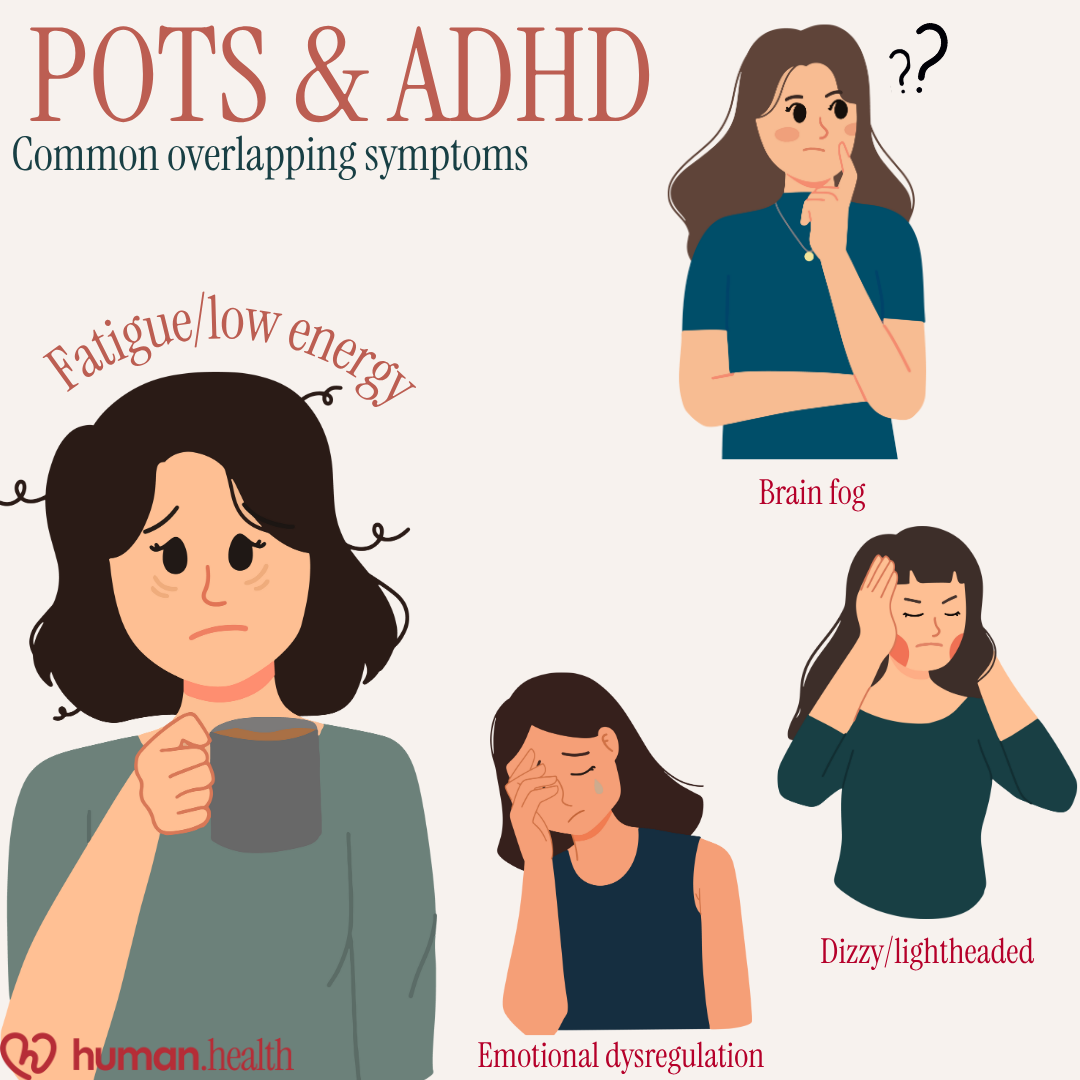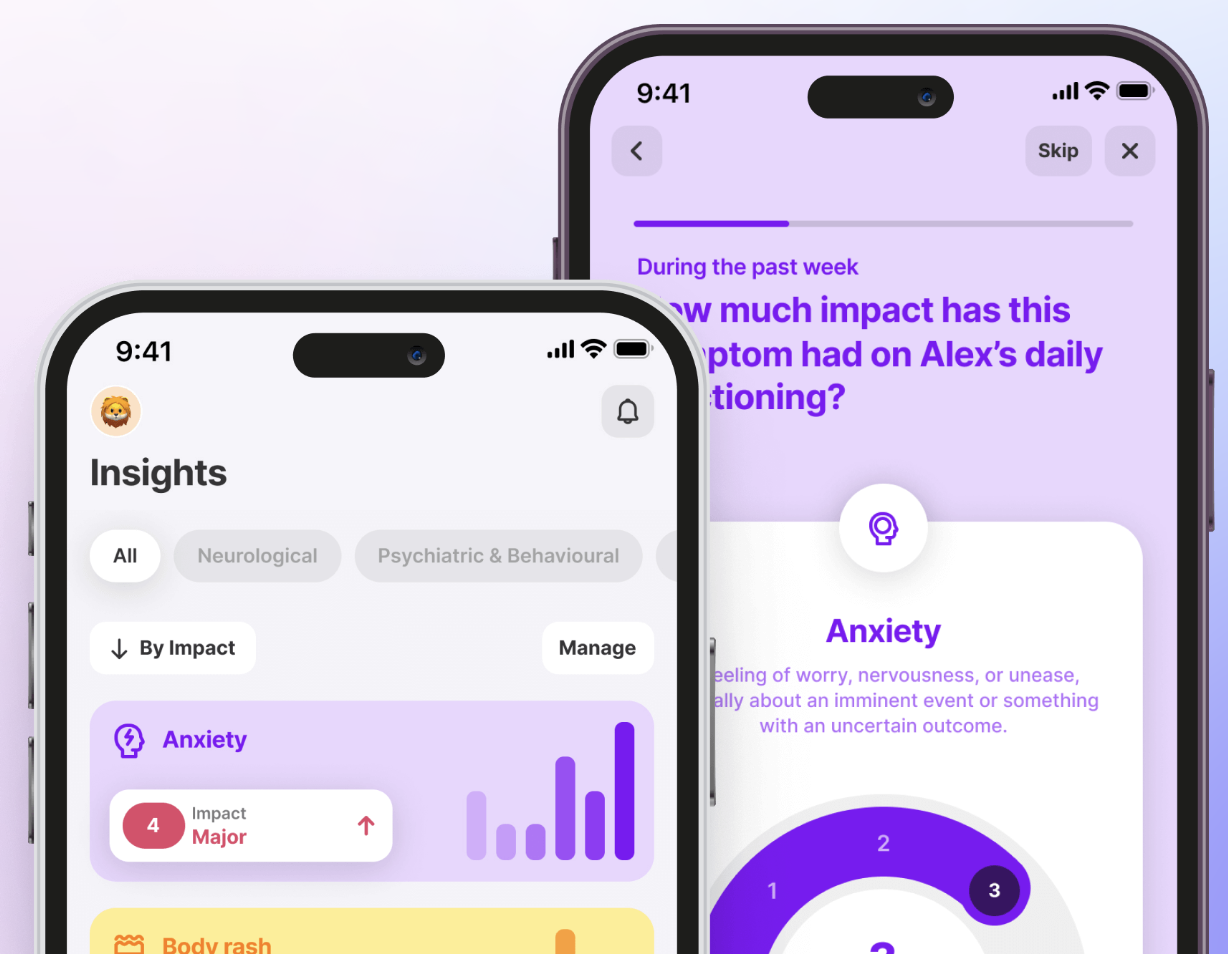POTS and ADHD: Shared Symptoms, Differences & More
September 2, 2025

- POTS and ADHD often overlap: Both conditions can share symptoms such as fatigue, brain fog, and trouble focusing, which can make diagnosis challenging.
- They affect different systems: ADHD is a neurodevelopmental condition linked to attention and impulse control, while POTS is an autonomic nervous system dysfunction that impacts blood flow and heart rate regulation.
- Shared symptoms may blur the lines: Difficulty concentrating, dizziness, and energy crashes can appear in both, but their root causes differ.
- Tracking may provide clarity: Using tools like the Human Health app’s symptom tracker can help you log and compare patterns, giving you clearer insights to discuss with your healthcare provider.
Disclaimer: Human Health is a health tracking platform and does not provide medical advice, diagnosis, or treatment. This information is intended to support, not replace, conversations with qualified healthcare professionals.
Standing up and feeling your heart race. Sitting down to work but losing focus within minutes. For many people, these aren’t isolated frustrations. They are daily realities of living with POTS (postural orthostatic tachycardia syndrome) and ADHD (attention-deficit/hyperactivity disorder).
The two conditions affect very different systems, yet their symptoms often collide. Fatigue, brain fog, and poor concentration can blur the line between what’s neurological and what’s physiological. That overlap makes it harder to find clear answers.
In this article, we’ll explore how POTS and ADHD connect, where they differ, and why their overlap matters for everyday life and diagnosis. You’ll also see how symptom tracking with the Human Health app can bring clarity when patterns feel confusing.
POTS and ADHD: Is there a link?
Research suggests there may be a connection between POTS and ADHD, though the relationship is not fully understood. Some studies report higher rates of ADHD traits in people with POTS, possibly due to shared experiences such as fatigue, poor concentration, or brain fog. While the two conditions affect very different systems, they can co-exist and add complexity to daily life. Only a healthcare provider can confirm a diagnosis of either condition.
ADHD as a neurodevelopmental condition
ADHD is a neurodevelopmental condition that affects attention, activity levels, and self-control. Its main traits, including inattention, hyperactivity, and impulsivity, can appear in different ways depending on the type described in the DSM-5: inattentive, hyperactive-impulsive, or combined.
ADHD can influence focus and daily functioning at school, work, and in relationships. Although symptoms often begin in childhood, they may continue into adulthood and change over time.
POTS as an autonomic nervous system condition
POTS, or postural orthostatic tachycardia syndrome, is a condition that affects the autonomic nervous system, the part of the body that controls things like heart rate, blood pressure, and circulation.
In POTS, blood flow and heart rate may not adjust properly when standing up, leading to symptoms such as a fast heartbeat, dizziness, lightheadedness, or fatigue. Many people also describe feeling “brain fog,” or difficulty concentrating. Because both POTS and ADHD can affect attention and focus, distinguishing between the two can sometimes be challenging.

ADHD shapes how the brain regulates attention and behavior, while POTS disrupts how the body regulates circulation. Understanding both side by side helps explain why symptoms can overlap but require different approaches.
Shared symptoms of POTS and ADHD
Although POTS and ADHD arise from different systems, their effects often look alike in daily life. This overlap can blur the picture for both patients and providers, making it difficult to separate one set of symptoms from the other.
Brain fog and poor concentration
Both ADHD and POTS can make it hard to think clearly. People often describe being forgetful, losing track of conversations, or struggling to stay focused as part of their cognitive dysfunction. For ADHD, this is linked to attention regulation, while in POTS it often arises from poor blood flow to the brain when upright.
In fact, formal testing shows people with POTS often score higher on inattention measures than healthy controls, even without a childhood history of ADHD (Raj et al., 2018, Journal of Neurology, Neurosurgery & Psychiatry).
Fatigue and low energy
Persistent fatigue is common in both conditions. In ADHD, it may stem from mental overexertion or disrupted sleep, while in POTS, it frequently worsens after standing, exertion, or blood pressure shifts. Tracking fatigue in the Human Health app’s symptom tracker can help reveal when and why your energy drops.

Dizziness and lightheadedness
Some people with ADHD may feel dizzy as a side effect of certain medications. In POTS, the body’s automatic control of blood flow and heart rate does not always adjust properly when standing, which can lead to dizziness or lightheadedness. In both situations, dizziness may make it harder to concentrate or carry out daily tasks.
Emotional regulation difficulties
Both conditions may contribute to mood swings or irritability. ADHD is strongly linked with emotion regulation difficulties, including impulsive emotional responses and frustration management challenges. POTS symptoms, especially when unpredictable, can lead to heightened stress or anxiety. This overlap can make it hard to tell whether mood changes are neurological or physiological in origin.
Recognizing these shared patterns matters. When one condition overshadows the other, symptoms can be misattributed, delaying proper support or leading to incomplete care. Careful tracking gives your healthcare provider a clearer picture, helping ensure that neither POTS nor ADHD is overlooked.

Physical & psychological impact of POTS & ADHD
The effects of living with POTS and ADHD ripple through daily life, influencing physical health, mental well-being, and how someone functions in school, work, and relationships.
Daily physical strain
In POTS, symptoms such as dizziness, a rapid heartbeat, and fatigue occur because the body’s circulation does not adjust as it should when standing. In ADHD, difficulties with sleep, such as insomnia or restless nights, can also affect energy and focus during the day. Together, these effects can create ongoing physical and mental strain. Using the Human Health app to track these symptoms may help you notice links with factors like heat, dehydration, or sensory overload.
Cognitive and emotional stress
Both POTS and ADHD can contribute to brain fog, attention challenges, and strong emotional reactions. Over time, these overlapping difficulties may lead to frustration or self-doubt. When a POTS flare happens at the same time as ADHD symptoms, it can increase stress and make daily tasks feel more difficult. Tracking how these moments occur can help you identify patterns and prepare for more focused conversations with your healthcare provider.

Social and functional impact
When symptoms overlap, keeping up with school, work, or relationships can become much harder. Fatigue, forgetfulness, and irritability may lead to missed deadlines or misunderstandings. Over time, some people reduce social contact or avoid group activities to prevent frustration or conflict. Recording how these symptoms affect your daily routines can help show others the real impact and support clearer communication with your healthcare provider.
When these impacts are misattributed to only one condition, people risk receiving incomplete care or support. Careful tracking can prevent one diagnosis from overshadowing the other, ensuring both POTS and ADHD are recognized in the challenges they create.
POTS and ADHD: Can you have both?
Yes, it’s possible to live with both POTS and ADHD. Because the two conditions affect different systems of the body, they can co-exist rather than one causing the other.
Studies suggest that people with POTS report higher rates of ADHD-like symptoms, but the overlap may also come from shared experiences like fatigue, brain fog, or poor sleep.
Having both can complicate diagnosis and daily management, since similar symptoms may be attributed to the wrong condition. This is why careful tracking of when and how symptoms occur (using tools like the Human Health app’s symptom tracker) can help you and your provider separate patterns and build a clearer picture of what’s happening.
{{inline-cta-1}}
Today’s available treatments for POTS & ADHD
Finding the right treatment is rarely straightforward when you’re living with both POTS and ADHD. What helps one condition can sometimes complicate the other, and it often takes time, patience, and close tracking to see what works best. While approaches differ, combining medical care with your own data can make it easier to identify patterns and communicate them clearly to providers.
ADHD
ADHD care often includes a combination of behavioral strategies, therapy, and medication. Stimulant medications such as methylphenidate or amphetamines are widely studied and shown to improve focus and reduce hyperactivity for many individuals. Non-stimulant options and cognitive behavioral therapy may also support daily functioning.
However, not all treatments work the same for everyone, and side effects can vary. Logging medication timing, sleep, and focus in the Human Health app may help identify patterns that inform better care discussions.
POTS
POTS management usually focuses on supporting the autonomic nervous system and reducing symptom severity. Research highlights approaches such as increased hydration and salt intake, compression garments, and graded exercise therapy.
Some people are prescribed medications like beta-blockers or fludrocortisone, but these are tailored to individual needs and require medical supervision. Because POTS symptoms can fluctuate, tracking daily routines (such as standing tolerance, heart rate, and fatigue) can reveal which interventions provide stability.
The biggest challenge isn’t just finding treatments; it’s balancing them.
Stimulants for ADHD may raise heart rate, while POTS strategies like fluid loading may do little for concentration. Careful tracking helps reveal when treatments are helping both conditions, and when they might be working against each other.
Lifestyle adjustments to counter POTS and ADHD
Managing daily life with both POTS and ADHD isn’t about a single fix. It’s about balance. What steadies one condition may sometimes unsettle the other, so small, consistent changes become the foundation for navigating both.
Building structured routines
Routine supports ADHD by reducing distraction and decision fatigue, while for POTS it can stabilize sleep, hydration, and recovery. A consistent daily rhythm helps both conditions feel less unpredictable. With the Human Health app’s treatment tracker, you can build routines and monitor how they influence symptoms over time.
Prioritizing sleep quality
Poor sleep worsens symptoms across the board. ADHD may cause racing thoughts at night, while POTS often disrupts rest with heart rate changes. Calming bedtime habits and reducing screens can help. Logging sleep quality in the Human Health app shows how rest, or lack of it, affects fatigue and focus the next day.
Gentle movement and pacing
Exercise intolerance in POTS and restlessness in ADHD can make activity a double-edged sword. Gentle movement such as stretching or slow walks often helps circulation and focus without overwhelming the body. Recording these sessions in the Human Health app lets you connect activity levels with dizziness, fatigue, or concentration.
Managing overstimulation
Noise, crowds, or stress can worsen symptoms in both conditions. Creating calm environments, using sensory tools, or pacing social commitments reduces overload. When you log overstimulation events in the Human Health app, patterns emerge that reveal which environments trigger symptoms most often.
Lifestyle changes won’t eliminate POTS or ADHD, but they can reduce the strain of living with both. Tracking how these adjustments play out day to day helps you see what genuinely supports you, and prevents trial-and-error from feeling endless.
How the Human Health app can help you manage POTS & ADHD
When two conditions overlap, it’s easy to feel like you’re piecing together a puzzle without the full picture. The Human Health app helps fill in those missing pieces by giving you a structured way to log symptoms and track treatments.
You can monitor fatigue, dizziness, sleep, or focus struggles side by side, then export your data as a clear PDF to share with your healthcare provider. This makes conversations more productive and helps ensure neither POTS nor ADHD is overlooked.
Start using the Human Health app’s symptom tracker today to uncover patterns, reduce uncertainty, and take a more active role in managing both conditions.
Frequently Asked Questions:
1. Can ADHD medications worsen POTS symptoms?
Some ADHD medications, especially stimulants, may increase heart rate or blood pressure. This can worsen POTS symptoms for some people, though experiences vary. Always discuss changes with your healthcare provider.
2. Are there any specific warning signs that my symptoms are due to POTS and not just anxiety or ADHD?
Yes , hallmark signs of POTS include dizziness, rapid heartbeat, and fatigue that appear after standing. These are distinct from anxiety-related symptoms, but only a doctor can confirm a diagnosis.
3. How can I tell if fatigue is from POTS, ADHD, or both?
It can be difficult to separate. POTS fatigue often follows standing or activity, while ADHD fatigue may stem from mental effort or poor sleep. Tracking when fatigue occurs can help you and your provider see patterns.
Sources:
- National Library of Medicine: Cognitive and Psychological Issues in Postural Tachycardia Syndrome
- National Library of Medicine: Water Ingestion in Postural Orthostatic Tachycardia Syndrome: A Feasible Treatment Option?
- National Library of Medicine: Joint Hypermobility Links Neurodivergence to Dysautonomia and Pain
- CHADD: About ADHD - Symptoms, Causes and Treatment
- CDC: ADHD in Adults: An Overview
- Johns Hopkins Medicine: Postural Orthostatic Tachycardia Syndrome (POTS)
- Johns Hopkins Medicine: POTS: A Little Known Cause of Extreme Fatigue
- US Pharmacist: Insights Into ADHD Treatment and Management
- National Library of Medicine: Postural Orthostatic Tachycardia Syndrome
- National Library of Medicine: Emotional dysregulation and Attention-Deficit/Hyperactivity Disorder
- Dovepress: Sleep disorders in patients with ADHD: impact and management challenges
- Autonomic Neuroscience: Basic and Clinical: Cognitive and psychological issues in postural tachycardia syndrome
- National Library of Medicine: Functional Impairments Associated With ADHD in Adulthood and the Impact of Pharmacological Treatment
Disclaimer: Human Health is a health tracking platform and does not provide medical advice, diagnosis, or treatment. The information on this site is intended to support, not replace, conversations with qualified healthcare professionals.
This is a div block with a Webflow interaction that will be triggered when the heading is in the view.


Keep track of your health condition
Log symptoms and notes. Set daily reminders, and keep track of the treatments you're trying inside the Human Health app.








.jpg)



.png)

